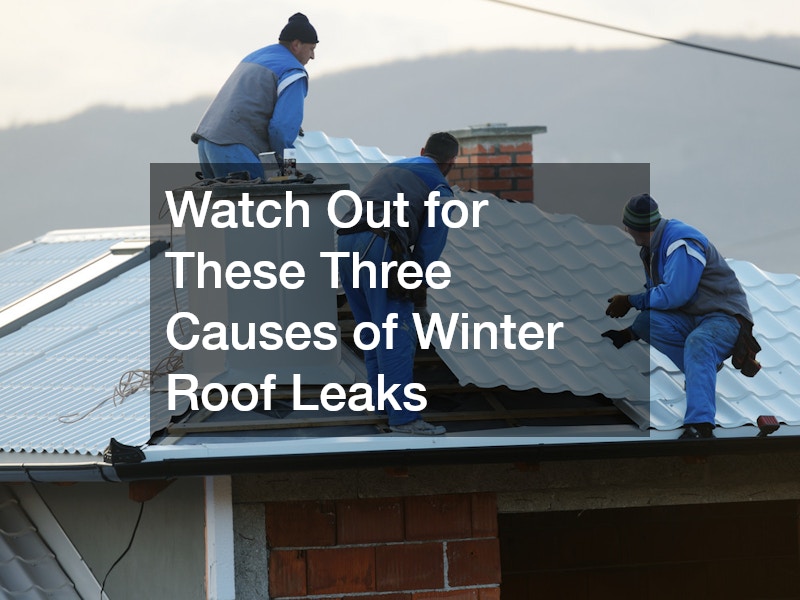


As a homeowner, you must protect your family with an intact roof. As the weather changes, you may not realize the colder weather can affect your roof’s security. To be proactive about protecting your roof, it’s a good idea to have a roof inspection done before the weather gets too cold. During an inspection, these professionals will check your roof. A roof inspection is an excellent opportunity to find a contractor you feel comfortable working with. It may also find a problem that requires minor roof repair. This will be an excellent opportunity for you to assess the quality of the contractors’ work. If their work is good, keep their phone number handy in case of an emergency. A skilled roof inspection company will understand that flashings and gutters can be one of the common reasons for roof leaks. If those structures become blocked by leaves during autumn or with ice in the winter, your roof will be at greater risk of leaking. You may wonder about roof repair solutions to use while waiting for the roof contractor to repair a roof. According to Today’s Homeowner, you should remove and replace damaged shingles as soon as possible.
If you’re a homeowner, one of your major safety concerns will be keeping your roof intact. One of the best ways to make that happen is collaborating with a local roof contractor to do an annual inspection. A yearly roof inspection will look at the roof’s surface and inspect your gutter guards. In addition to checking your roof, they will often make any minor roof repairs they discover during the inspection. If you have a new home and discover your new roof leaking, you will understandably be upset. It’s natural to expect a new home to be structurally intact. However, if this does occur, find a trustworthy local roof contractor to make the needed repairs – and then talk to them in advance about performing an annual inspection.
You may wonder, what causes ceiling leaks? It will likely be due to a leaking pipe or a roof problem. “How long can you leave a leaking roof?” A leak in your roof should never be ignored, making it important to be attentive immediately. Although a small leak may cause minimal damage, its impact can escalate quickly – and it will cost less to address the problem while it’s small. If you find that either your gutters, gutter guards, or roof have damage, you need to hire a professional right away before your home is damaged further.

Most people think of leaking roofs in the summer and spring months when rain increases. There is, however, a risk of a leaky roof even in the colder winter months. Roof leak issues are not all that uncommon. House leak repair is often one of the most frequent things that homeowners have to deal with as materials do break down and do degrade over time. When it comes to how to find a leak in your roof, you should watch for water spots in the ceiling, look for dripping, and smell for mold as these are all signs that leaks may be afoot.

For those that are looking how to repair your roof, a roofing company is always going to be your best bet — unless of course, you are a roofer and know how to do the repairs yourself. A leak coming through ceiling tiles is often a very bad one as much of the smaller leaks are going to be caught in the attic of the home. If you have a leaky roof, it is always best to seek professional help to tend to these issues and get your roof back in perfect working order and leak-free.

There are several home roofing options out there, and all of them are vulnerable to three major problems during winter. Here’s what to look out for:
-
- Check the Flashing
If your roof is leaking, it’s possible that the flashing on your roof was damaged or weathered. Most home roofing options use flashing, which consists of angled sheet metal that covers roof joints and prevents water from seeping in. Usually you’ll find flashing around chimneys, skylights or protruding windows. If you find that leaks are coming from these areas, it’s likely that your flashing is to blame.
If the flashing is only slightly corroded or has a few small holes, you may be able to fix the problem with roofing cement. Flashing that needs patches larger than about three fourths of an inch will likely require professional roofing repair.
- Check the Flashing
-
- Watch Out for Ice Dams
Ice dams are among the most common roof issues for all home roofing options and styles. Ice dams form when heat from the attic warms the deck of your roof. The lowest layer of snow on your roof melts and flows down to your roof gutters and downspouts. If your roof downspouts or gutters are dirty or clogged, the water has nowhere to go, and it refreezes on the end of your roof. The water that doesn’t freeze tends to wash back under your shingles and leak into the inside of your home.
Clean your gutters and downspouts between snowfalls, and make sure your attic is properly insulated and ventilated. A good water-proofing shingle underlayment can help prevent leaks.
- Watch Out for Ice Dams
- Beware of Condensation
Condensation occurs when warm air hits a cold roofing system. This often occurs in attics with poor ventilation and improper insulation. Generally, water droplets form in the attic when the sun is out, which can lead to mold, wet insulation, and ultimately roof failure. Usually you’ll need to call in a professional to fix condensation issues.
Ask a professional to evaluate your roof to make sure you’re fully prepared for winter.